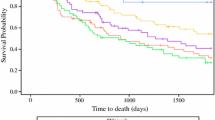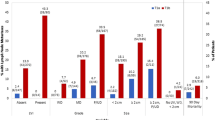Abstract
Background
The tumor, node, metastasis classification system for staging esophageal cancer does not include tumor volume although it may be an important prognostic factor. We evaluated the prognostic value of tumor volume in esophageal cancer.
Methods
We performed a retrospective study in patients with histologically confirmed primary esophageal cancer who underwent curative esophagectomy at our facility between April 1992 and December 2013. The Tumor Depth Parameter (TDP) was defined as mucosa = 1, submucosa = 2, muscularis propria = 3, adventitia = 4, and invasion into adjacent organs = 5. The pathological Tumor Volume Index (TVI) was defined as the major axis × the minor axis × TDP. The appropriate tumor diameter and TVI cutoff values were determined by the Youden index obtained from the receiver operating characteristic curve. Prognostic factors for overall survival were evaluated by univariate analysis and Cox proportional hazards regression models.
Results
We enrolled 302 patients. In the univariate analysis, patient age and sex, thoracoscopic surgery, tumor depth of invasion and diameter, lymph node metastasis, and the TVI were significantly associated with overall survival. In our multivariate analysis, patient age and sex, thoracoscopic surgery, lymph node metastasis, and the TVI were independently associated with overall survival.
Conclusions
The pathological TVI was an independent prognostic factor in patients with esophageal carcinoma and could be included in the staging system of esophageal cancer.



Similar content being viewed by others
References
Jemal A, Siegel R, Ward E, Hao Y, Xu J, Murray T, Thun MJ. Cancer statistics, 2008. CA Cancer J Clin. 2008;58:71–96.
Wittekind C, Yamasaki S. Digestive System Tumours–Oesophagus including oesophagogastric junction. In: Sobin LH, Gospodarowicz MK, Wittekind C (eds) TNM classification of malignant tumours, 7th edn. New York: Wiley-Blackwell, 2009:66.
Kunisaki C, Makino H, Takagawa R, et al. Tumor diameter as a prognostic factor in patients with gastric cancer. Ann Surg Oncol. 2008; 15:1959–67.
Yendamuri S, Swisher SG, Correa AM, et al. Esophageal tumor length is independently associated with long-term survival. Cancer. 2009;115:508–16.
Choi JY, Jang HY, Shim YM, et al. 18F-FDG PET in patients with esophageal squamous cell carcinoma undergoing curative surgery: prognostic implications. J Nucl Med. 2004;45:1843–50.
Igaki H, Kato H, Tachimori Y, Sato H, Daiko H, Nakanishi Y. Prognostic evaluation for squamous cell carcinomas of the lower thoracic esophagus treated with three-field lymph node dissection. Eur J Cardiothorac Surg. 2001;19:887–93.
Urba SG, Orringer MB, Turrisi A, Iannettoni M, Forastiere A, Strawderman M. Randomized trial of preoperative chemoradiation versus surgery alone in patients with locoregional esophageal carcinoma. J Clin Oncol. 2001;19:305–13.
Yu Y, Guan H, Xing LG, Xiang YB. Role of gross tumor volume in the prognosis of non-small cell lung cancer treated with 3D conformal radiotherapy: a meta-analysis. Clin Ther. 2015;37:2256–66.
Issa MR, Samuels SE, Bellile E, Shalabi FL, Eisbruch A, Wolf G. Tumor volumes and prognosis in laryngeal cancer. Cancers (Basel). 2015;7:2236–61.
Schiavina R, Borghesi M, Chessa F, et al. The prognostic impact of tumor size on cancer-specific and overall survival among patients with pathologic t3a renal cell carcinoma. Clin Genitourin Cancer. 2015;13:e235–41.
Kim KH, Lim SK, Shin TY, et al. Tumor volume adds prognostic value in patients with organ-confined prostate cancer. Ann Surg Oncol. 2013; 20:3133–9.
Chen Y, Zhang Z, Jiang G, Zhao K. Gross tumor volume is the prognostic factor for squamous cell esophageal cancer patients treated with definitive radiotherapy. J Thorac Dis. 2016;8:1155–61.
Créhange G, Bosset M, Lorchel F, et al. Tumor volume as outcome determinant in patients treated with chemoradiation for locally advanced esophageal cancer. Am J Clin Oncol. 2006;29:583–7.
Hatt M, Visvikis D, Albarghach NM, Tixier F, Pradier O, Cheze-le Rest C. Prognostic value of 18F-FDG PET image-based parameters in oesophageal cancer and impact of tumour delineation methodology. Eur J Nucl Med Mol Imaging. 2011;38:1191–202.
Hyun SH, Choi JY, Shim YM, et al. Prognostic value of metabolic tumor volume measured by 18F-fluorodeoxyglucose positron emission tomography in patients with esophageal carcinoma. Ann Surg Oncol. 2010;17:115–22.
Roder JD, Busch R, Stein HJ, Fink U, Siewert JR. Ratio of invaded to removed lymph nodes as a predictor of survival in squamous cell carcinoma of the oesophagus. Br J Surg. 1994;81:410–3.
Eloubeidi MA, Desmond R, Arguedas MR, Reed CE, Wilcox CM. Prognostic factors for the survival of patients with esophageal carcinoma in the U.S.: the importance of tumor length and lymph node status. Cancer. 2002;95:1434–43.
Ellis FH Jr, Heatley GJ, Krasna MJ, Williamson WA, Balogh K. Esophagogastrectomy for carcinoma of the esophagus and cardia: a comparison of findings and results after standard resection in three consecutive eight-year intervals with improved staging criteria. J Thorac Cardiovasc Surg. 1997;113:836–46.
Korst RJ, Rusch VW, Venkatraman E, et al. Proposed revision of the staging classification for esophageal cancer. J Thorac Cardiovasc Surg. 1998;115:660–9.
Gill PG, Denham JW, Jamieson GG, Devitt PG, Yeoh E, Olweny C. Patterns of treatment failure and prognostic factors associated with the treatment of esophageal carcinoma with chemotherapy and radiotherapy either as sole treatment or followed by surgery. J Clin Oncol. 1992;10:1037–43.
Lagarde SM, ten Kate FJ, Reitsma JB, Busch OR, van Lanschot JJ. Prognostic factors in adenocarcinoma of the esophagus or gastroesophageal junction. J Clin Oncol. 2006;24:4347–55.
Tullie LG, Sohn HM, Zylstra J, et al. A role for tumor volume assessment in resectable esophageal cancer. Ann Surg Oncol. 2016;23:3063–70.
Chan DSY, Fielding P, Roberts SA, Reid TD, Ellis-Owen R, Lewis WG. Prognostic significance of 18-FDG PET/CT and EUS-defined tumour characteristics in patients with oesophageal cancer. Clin Radiol. 2013; 68:352–7.
Kauppila JH, Wahlin K, Lagergren P, Lagergren J. Sex differences in the prognosis after surgery for esophageal squamous cell carcinoma and adenocarcinoma. Int J Cancer. https://doi.org/10.1002/ijc.31840.
Takeno S, Takahashi Y, Moroga T, Kawahara K, Yamashita Y, Ohtaki M. Retrospective study using the propensity score to clarify the oncologic feasibility of thoracoscopic esophagectomy in patients with esophageal cancer. World J Surg. 2013;37:1673–80.
Disclosure
Hiroshi Miyamoto has no disclosures to declare.
Author information
Authors and Affiliations
Corresponding author
Additional information
Publisher's Note
Springer Nature remains neutral with regard to jurisdictional claims in published maps and institutional affiliations.
Electronic supplementary material
Below is the link to the electronic supplementary material.
Supplementary Fig. 1
Preoperative TVI assessed by the imaging modalities was correlated with the pathological TVI (r = 0.665, P < 0.001) (TIFF 107 kb)
Rights and permissions
About this article
Cite this article
Miyamoto, H., Kunisaki, C., Sato, S. et al. Tumor Volume Index as a Prognostic Factor in Patients after Curative Esophageal Cancer Resection. Ann Surg Oncol 26, 1909–1915 (2019). https://doi.org/10.1245/s10434-019-07308-9
Received:
Published:
Issue Date:
DOI: https://doi.org/10.1245/s10434-019-07308-9




